Physical Fish Barriers
A requirement for Reclamation to construct fish barriers within the Gila River basin was established in the 1994 and later biological opinions (2001 and 2008) from the U.S. Fish and Wildlife Service (USFWS) on impacts of delivery of Central Arizona Project (CAP) to federally-listed fishes. Those opinions concluded that the CAP would serve as a conduit for introductions of non-native fishes and other aquatic species from the Colorado River (the CAP source) to habitats occupied by native fishes in the Gila River basin. As a result, a conservation measure was implemented to construct fish barriers in priority streams in order to prevent or hinder upstream movements of non-native fish and other aquatic organisms into high-value native fish and amphibian habitats during the 100-year life of the CAP (2008 BO). As described in the 2008 BO, Reclamation has committed to constructing 12 fish barriers by 2023. As of 2018, Reclamation has constructed physical barriers in eight streams (Aravaipa Creek, Cottonwood Spring, Fossil Creek, Bonita Creek, Hot Springs Canyon, Blue River, Spring Creek, West Fork Black River), and has plans to construct barriers in Redfield Canyon, Eagle Creek, and Verde River.
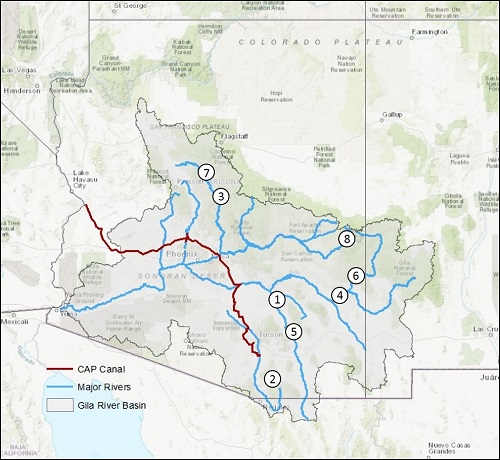
Map of completed physical fish barriers. Barrier number corresponds with number on table below.
| Location | Year Completed | NEPA | Click On Photo For Additional Photos/Figures |
| 1. Aravaipa Creek | 2001 | Aravaipa Creek EA | 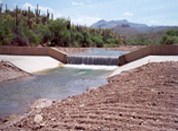 |
| 2. Cottonwood Spring | 2004 | Cottonwood Spring EA | 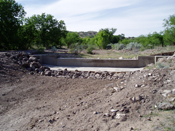 |
| 3. Fossil Creek | 2004 | Fossil Creek EA | 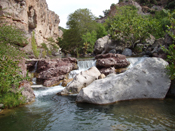 |
| 4. Bonita Creek | 2008 | Bonita Creek EA | 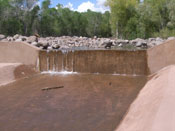 |
| 5. Hot Springs Canyon | 2010 | Hot Springs EA | 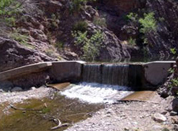 |
| 6. Blue River | 2012 | Blue River EA | 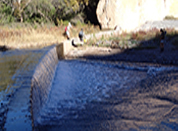 |
| 7. Spring Creek | 2015 | Spring Creek EA | 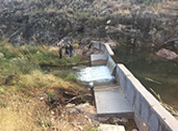 |
| 8. West Fork Black River | 2016 | West Fork Black River EA | 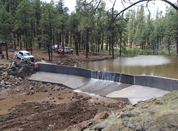 |
Before a barrier can be constructed, biologists and engineers investigate the feasibility of the site to see if it is suitable for construction. Below is a list of fish barrier investigation reports.
- Verde River Fish Barrier Appraisal-Level Investigations
- Rock Creek Fish Barrier Feasibility Investigations
- O'Donnell Creek Fish Barrier Feasibility Investigations
- Redrock Canyon Fish Barrier Feasibility Investigations
- Upper Gila Basin New Mexico Fish Barrier Feasibility Investigations
- Lewis Springs Fish Barrier Phase 1 Investigations
- Bonita Creek Fish Barrier Phase 1 Investigations
- Granite Creek Fish Barrier Site Investigation
- Fossil Creek Fish Barrier Phase 1 Conceptual Study
- East Fork White River Fish Barrier Feasibility Study
- Blue River Fish Barrier Feasibility Study
Fish monitoring is conducted for a mimumum of five years after the construction of a barrier to evaluate its effectiveness and provide information on the fish community. Below is a list of fish monitoring reports for the most recently constructed barriers.
- 2021 West Fork Black River Fish Barrier Monitoring
- 2020 West Fork Black River Fish Barrier Monitoring
- 2019 West Fork Black River Fish Barrier Monitoring
- 2017 West Fork Black River Fish Barrier Monitoring
- 2020 Spring Creek Fish Barrier Monitoring
- 2019 Spring Creek Fish Barrier Monitoring
- 2018 Spring Creek Fish Barrier Monitoring
- 2019 Blue River Fish Barrier Monitoring
- 2018 Blue River Fish Barrier Monitoring
- 2017 Blue River Fish Barrier Monitoring
- 2014 Blue River Fish Barrier Monitoring
- 2013 Blue River Fish Barrier Monitoring
- 2012 Blue River Fish Barrier Monitoring
- 2014 Hot Springs Canyon Fish Barrier Monitoring
- 2013 Hot Springs Canyon Fish Barrier Monitoring
- 2012 Hot Springs Canyon Fish Barrier Monitoring

